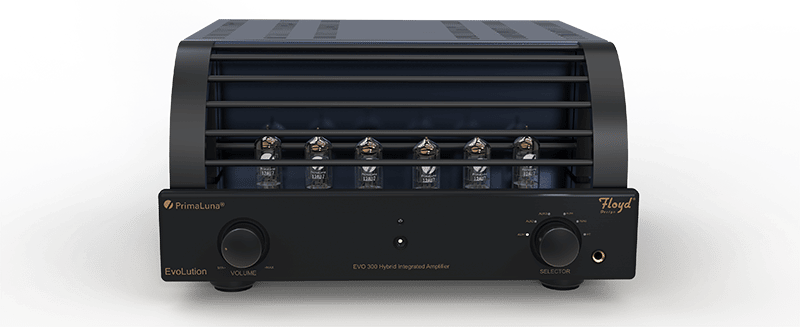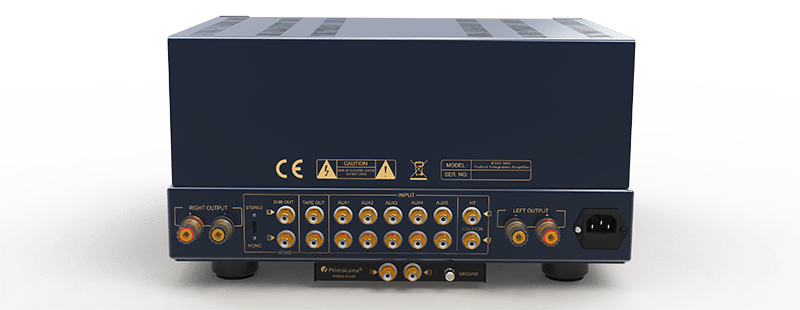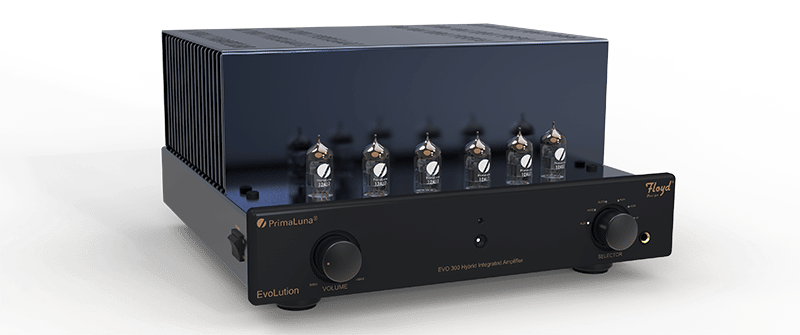The best of both worlds? PrimaLuna’s new EVO300 Hybrid Integrated delivers a sweet-sounding ‘valve experience’ but in a high-powered amplifier…
Consumers buying their first audio systems are not at all surprised that there are differences in sound quality between different speakers. After all, even if you know nothing at all about the technologies underlying differently designed loudspeakers, it seems commonsense that large speakers in large cabinets would be louder than small speaker in small cabinets, and that large speakers would produce deeper bass than smaller ones.
Yet those self-same consumers are always completely surprised that there are differences in sound quality between different amplifiers. The differences in sound quality between amplifiers that are entirely constructed using solid-state components — transistors, MOSFETs, are sufficiently subtle that it usually takes a discerning ear to hear them, assuming that variables such as power output, circuit noise and damping factor are taken into account.
However the differences in sound quality between amplifiers that use old-fashioned valve technologies — “valve” or “tube” amplifiers — and that of solid-state amplifiers are immediately obvious, even when the variables are taken into account, and in most cases, listeners prefer the sound quality of amplifiers that use valves.
So why do most consumers end up buying solid-state amplifiers?
There are many reasons, but perhaps the most significant is the cost of maintaining a valve amplifier in peak condition. Whereas a solid-state amplifier requires no maintenance at all to ensure a specific continued level of performance, valve amplifiers require not only that you replace the different valves at different intervals, but also (sometimes) that you regularly adjust the operating voltages, which is known as ‘valve biasing.’
With some experts (Paul McGowan, of PS Audio) recommending that you replace valves on a yearly basis, this could get very expensive, since a typical KT-88 output valve can cost up to $200, and since you should replace these as a set, you’ll be looking at a running cost of $800 per annum. And if your amplifier does require you to adjust valve bias (some amplifiers do this for you automatically), you’ll need to put this into your calendar as a regular event.
For the record, I don’t agree with McGowan’s yearly replacement schedule (and for the record, PS Audio makes only solid-state amplifiers, which could have influenced his thinking somewhat). My late father-in-law owned a Quad amplifier whose valves hadn’t been replaced in more than a decade, and it still sounded great, but I’d put five years as the sweet spot for valve replacement.
But there is a way of getting most of the advantages of ‘valve sound’ without most of the disadvantages, which is by buying an amplifier that uses a combination of solid-state and valve technologies… a so-called ‘Hybrid’ amplifier.
The Equipment
The Prima Luna EVO 300 Hybrid Integrated amplifier uses valves in the initial amplification stages and transistors in the final output amplification stages. Doing it this way delivers that desirable ‘valve sound’ but eliminates the need for those expensive output valves, so you need only replace input valves. Not only are these far less costly to replace ($32 each) but also, because they are not as stressed as output valves, they don’t have to be replaced anywhere near as often. Depending on how often you listen to music, you might be looking at replacing them after ten years or more. And unlike output valves, there’s no need to bias them, so you can free up your calendar for other events.
Prima Luna has made the hybrid nature of the EVO 300 obvious by putting the six 12AU7 input valves right up front. They are protected by a removable valve cage comprised of six horizontal bars positioned sufficiently close together to prevent an inquisitive finger (or paw) from a potential valve burn. (Yes, Virginia, valves can get very hot, which is the reason electronics textbooks refer to them as ‘thermionic devices’.)
Whereas most valve cages are ugly affairs, so many audiophiles ignore the dangers and operate their amplifiers without them, I personally think the EVO 300 looks better with its cage fitted than without, so in this case, it’s a win–win.
Prima Luna has for some reason put the mains power switch on the left-hand side of the amplifier rather than on the front panel, which means that you will need to position the amplifier so that it’s easily accessible. Being a part-valve amplifier necessarily means it will take more time to ‘heat up’ than a completely solid-state amplifier, so once you’ve pressed the power button it will take more than a minute (around 64 seconds) to initialise, during which time the LED on the front panel will shine bright red and you won’t be able to use either the controls on the front panel or those on the infra-red remote control.
Once initialisation is complete the LED turns green and you’re able to use the left-most rotary control to select your desired signal source from the five available line-level inputs (there’s also a pass-through input for anyone desirous of integrating the EVO 300 into a multi-channel home theatre system). Rather unusually these days, all five inputs are unbalanced types — it would have been preferable for at least one of the five to have been a balanced type, accessible via XLR sockets on the rear panel.
The front-panel volume control feels very nice under the fingers, which is nice, but in most cases you’re more likely to use the supplied remote control to adjust volume, if only because it’s easier to set levels precisely when you’re in the listening position. The speed of volume adjustment from the remote is quite slow (15 seconds to get from maximum to minimum or vice versa) but at least this very slowness allows more precise level setting.
The remote control offers a ‘Mute’ function that is not available on the front panel, but I was disappointed to find that if you adjust the volume level whilst the muting circuit is engaged, it does not automatically disengage. Although I might not expect the mute to automatically disengage when the front panel control is adjusted, I would certainly expect this to occur when using the volume buttons on the remote. This design oversight introduces the possibility of speaker damage if the amplifier is used by someone inexperienced in the amplifier’s operation. That said, however, this is a design oversight that is made by a great many other amplifier manufacturers as well.
As for the remote control itself, it’s unusual because it haswo rubber ‘bands’ encircling it — one at either end. I say ‘rubber bands’ but they’re more like thick rubber rings. These serve several purposes. The one I found most useful is to prevent the control from sliding if it’s placed on a smooth surface. A minor point, perhaps, but extremely useful, because it not only prevents the control from scratching any surface on which it’s placed, but also means it can’t slide off a surface and fall to the floor, where it could itself be damaged.
The rubber rings also serve to elevate the control a little above whatever surface it’s sitting on, which makes it easier to pick up than it might otherwise have been. The final purpose is that the bands hide from sight the four small silver screws that need to be removed in order to install the batteries that power it. Unlike some manufacturers, which provide low-cost batteries that are prone to leaking, PrimaLuna supplies high-quality Eveready Alkaline Plus batteries.
All the input and output terminals (except for the speaker terminals) fitted to the rear of the EVO 300 Hybrid are supplied with plastic protective covers. These keep the terminals clean, but also minimise potential oxidisation. Obviously you need to remove the covers on the terminals you need you need to use, but I would recommend leaving the covers on any unused terminals.
In addition to the terminals you’d expect to find on any integrated amplifier, the EVO 300 Hybrid also has a pair of pre-amplifier output terminals and two subwoofer output terminals that can be switched between stereo and mono operation via a switch on rear panel. These outputs are full frequency range, not low-pass filtered.
I could not locate a User Manual in the packaging of the amplifier I was supplied for review, and when I went on-line to locate one, I could only find one for the non-hybrid version of this amplifier — the PrimaLuna EVO300. This showed that the fully-valve version is operationally identical to this Hybrid version. It also showed that it’s possible to add an external phono preamplifier to the underside of the EVO300 Hybrid’s chassis. If you do this, you lose the AUX2 input (which would be a good time to make use of those plastic RCA input covers).
The full-sized (6.35mm) headphone socket on the front panel comes with a twist, which is that to use it, you have to flick a rocker switch on the right–hand edge of the EVO 300 Hybrid and, when you do this, you automatically disconnect the output stage from the speaker terminals, so you won’t hear anything from your speakers. So you can listen via speakers or via headphones, but not both simultaneously. I suspect this is because of the way the circuit was configured for the valve version, since a Hybrid amplifier should be able to drive both at the same time.
Floyd Design
If you’re wondering about that logo on the right hand side of the Evo 300 Hybrid, the story behind this is that although PrimaLuna is Italian for ‘First Moon’ (which is what we’d call a ‘New Moon’) the company is not Italian, but Dutch, and is owned by Herman van de Dungen, whose even-more-famous company, Durob Audio, is based in the Netherlands. Van de Dungen is such a fan of Pink Floyd that he named a subsidiary company owned by Durob Audio, one that designs the electronics used in all the brands build by Durob Audio, including PrimaLuna, Floyd Design. Behind the scenes at Floyd Design are Jan de Groot, who’s worked for van de Dungen for more than 20 years and takes care of the solid-state side of things, while the valve sections are the work of Marcel Croese, who once worked for Swiss outfit Goldmund.
Valve sound
I am often asked why it is that valve amplifiers can sound different to solid-state amplifiers. I think the most significant reason for the difference is that valves are microphonic, which means they can act as microphones and pick up sounds in the room, or vibrations, and add these sounds to whatever sounds are being ‘amplified’. For example, if you turn up the volume on a valve amplifier and whistle loudly close to one of the valves, you will hear whatever tune you are whistling through your loudspeakers (only very faintly, of course, but it will be there).
This would seem to be an undesirable trait, but in operation, the sound being picked up by the valves will be the music that’s coming from your loudspeakers, the self-same music that’s already being amplified, and the result is a pleasantly rich and warm sound. This is one reason that almost all rock guitarists use valve amplifiers. In their case, because the speakers are in the same cabinet as the valves themselves, the valves are reacting not only to air vibrations, but also to the physical vibrations coming through the cabinet caused by the motion of the speaker cone, so the microphonic effect is enhanced.
Another factor is that, as a general rule, distortion created when a valve amplifier reproduces a musical note of any pitch will be harmonically related to that note in a way that makes the sound of that note seem richer than it would otherwise be. So if that musical note is, say, A4 (which is 440Hz), the ‘distortion’ will be a small amount of sound at 880Hz, which you’d hear as the musical note A5: in other words, the ‘A’ exactly one octave above. To hear how this type of ‘distortion’ could benefit sound quality, press any key on a piano, then press that same key, but also the key that is an octave above it.
A further reason for sonic differences is that the frequency response of amplifiers that use valves in their output stage will vary quite dramatically depending on the impedance of the loudspeakers that are connected to it. This does not apply in the case of the EVO 300 Hybrid, however, as it does not use valves in its output stage.
As for valves being an ‘old-fashioned’ technology, the fact is that if you own a microwave oven, you already have a valve-powered device in your home because the microwaves that heat the food are created by special type of high-power valve called a cavity magnetron.
Listening Sessions
One huge advantage that hybrid amplifiers with solid-state output stages have over most full-fledged valve amplifiers was obvious right from the get-go, which is the very high power output of the EVO 300 Hybrid. My speakers are relatively inefficient, so it takes quite a bit of power just to get them up to ‘audition’ levels, and the PrimaLuna was very easily able to achieve that… plus and quite a bit more.
Even when I turned up the volume to levels far higher than I would normally, the PrimaLuna EVO 300 Hybrid was still punching out clean, undistorted sound, with no clipping whatsoever, and at the same time maintaining total fluidity in the high frequencies and solid, dramatic punchiness in the low frequencies. OK, so it is possible to buy full valve amplifiers with equivalent power output capability, but you’ll be paying for it — and you’ll have that many more valves to replace!
Since I m speaking of bass punch, this is another area where the solid-state output stage of the PrimaLuna EVO 300 Hybrid has the advantage over, say, PrimaLuna’s valve version of the same amp: the output impedance of a valve amplifier is much higher than that of a solid-state amplifier, which means the solid-state output stage will have much better control over the motion of the bass driver, effectively clamping down on unwanted cone motion caused by inertia, plus, as I noted previously whereas the sound of valve amplifiers will vary quite dramatically depending on the speakers used with them, the sound of a solid-state output stage will be much less affected.
For a great musical example of how the level of control afforded by the PrimaLuna 300 Hybrid improves sound quality, not only in the bass, but also across the midrange, you need only fire up Beyonce’s Break My Soul, a track from her latest album, ‘Renaissance’ (and her most controversial album as well, thanks to the ‘ableist’ slur on the track Heated). Totally designed for the dance floor, this 115 BPM track totally depends on precise timing, instantaneous bass attack and precise sonic cut-offs to deliver its message, and the PrimaLuna delivered all of this beautifully. Although it uses samples from other artists (Big Freedia and Robin S), it’s all mixed so transcendently that you’re carried along with the flow. Listen particularly to the keyboards and also the cymbal work, as well as to the complex vocal backgrounds created by The Samples Choir.
Hang around for the track that follows, Church Girl, and you’ll hear even deeper bass than on Break My Soul and, if you turn the volume up on this one, that the EVO 300 Hybrid responds to that bass beautifully, delivering all the depth and power you will ever need, and yet again with total control.
For a great example of how valves deliver sound that’s uniquely musical, I’d recommend listening to Kathryn Joseph’s new album, ‘for you who are the wronged’ (and yes, like e. e. cummings, she’s a fan of lower case type). The opening track, what is keeping them alive makes me want to kill them for, sustains sounds for tens of seconds (and more) while introducing competing sounds (including Joseph’s breathy vocals) and the EVO 300 Hybrid sustains these sound-fields with a magical delivery that eludes pure solid-state electronics. Pay particular attention to the sound during the track’s close-out. The delicate sound of Lomond Campbell’s modular synths throughout this album (supporting Joseph’s own keys) is a master-class of subtlety, and is rendered exactly by the PrimaLuna.
If you’d like to hear how accurately the EVO 300 Hybrid reproduces the sound of real instruments — saxophones, flutes, clarinet, tuba and drums — fire up Sons of Kemet’s fourth album from back in 2021, ‘Back to the Future’ and strap in for great sound … and a very wild ride! And if, while you’re listening, you’re wondering how one drummer can manage all that percussion without multi-tracking, it’s actually two drummers, Tom Skinner and Eddie Hick. Theon Cross (tuba) must have thought all his Christmases had come at once when he got to replace Oren Marshall (the band’s original tuba-ist) because the tuba has never before been placed so front and centre as it is in Sons of Kemet’s compositions.
For evaluating the presentation of male vocal, I am partial to a bit of James Taylor, so it was one of my favourites, Carolina in my Mind, that I turned, to find that his voice was as rich and realistic as I’ve heard him in the concerts of his that I’ve attended over the years. I could also hear the way he makes his usually rich baritone a little more nasal than usual when he sings Fire and Rain. Subtle, but audible thanks to the PrimaLuna’s transparency. I love this song too, with its lovely strings and piano, all delivered realistically by the PrimaLuna EVO 300 Hybrid… plus, of course, there’s his signature six-string acoustic sound.
For evaluating female vocal, my go-tos are anything at all by Joni Mitchell and k.d. lang’s ‘Hymns of the 49th Parallel’. Joni because I love her voice and her compositions, ‘Hymns’ because I love k.d. lang’s voice and the compositions on this particular album (all written by Canadians, including two by Mitchell and only one — Simple — by lang herself, though it was co-written by David Piltch). Again the EVO 300 Hybrid did both artists proud. The purity of the tonality it delivered was amazing, whether it was the glassy effervescence of Mitchell’s falsetto, or the slight rasp of lang’s flawless alto.
Listening to ‘Hymns’, I was floored by how well the EVO 300 Hybrid highlighted lang’s absolutely perfect pitching and her uncanny ability to introduce (or remove) vibrato at any point. I am absolutely certain her version of Leonard Cohen’s Hallelujah is the best recorded by a female vocalist, though I’d give the overall award for best rendition of this particular song to John Cale. (One of my favourite anecdotes about Hallelujah is that when Bob Dylan started including it on his playlist at concerts, he reportedly asked Cohen how long it had taken him to write. Cohen answered “a couple of years” before asking how long it had taken Dylan to write I and I, to which Dylan replied “15 minutes”.)
Conclusion
Why would you buy a ‘hybrid’ audio amplifier, rather than a fully solid-state amplifier, or a fully valved amplifier? That’s a question that only you can answer, but I think one reason could be the self-same one that SUVs are so popular in Australia: drivers realise that although conventional vehicles are superior on paved roads, they’re not much good on dirt, and conversely that four-wheel drive vehicle are great for off-road, but not so great anywhere else. Buying an SUV ‘kind-of’ gives you the best of both worlds.
In much the same way, PrimaLuna’s new EVO300 Hybrid Integrated delivers most of that sweet-sounding ‘valve experience’ but in a high-powered amplifier that requires almost no maintenance and will deliver that same great valve sound no matter what loudspeakers you choose to use with it.
The PrimaLuna EVO 300 Hybrid Integrated Amplifier is available from Len Wallis Audio in Silver or Black Finishes for $10,995.
# greg borrowman
Len Wallis Audio has commissioned the services of Greg Borrowman, who has been the editor of Australian Hi-Fi magazine for over four decades, to write a number of subjective based reviews on the products that we carry. While Greg is paid for this service it is under the assumption that there is no editorial pressure from any one at Len Wallis Audio – if he finds fault with the product it is expected that he says so.








Good to have an in-depth review like this from someone we know and trust. However, I was a little surprised there were no lab test results, and no price quoted.
Thanks Peter. Part of our guidelines for Greg was for his reviews to be more subjective than technical. We believe that there are enough publications out there doing a good job of the technical side.
The amp sells for $10,995.
Regards, Len
I do like this review however I need to point out the high end PS Audio products have valves at their input stage. I recall Paul stating, he had to be convinced the hybrid setup will result in the best sound. Good to hear changing valves every year is not really required if they are at the imput stage. Look forward to the next review. Regards Mark
Thanks for the feedback Mark – we are hoping to do one of these every month.
Regards, Len